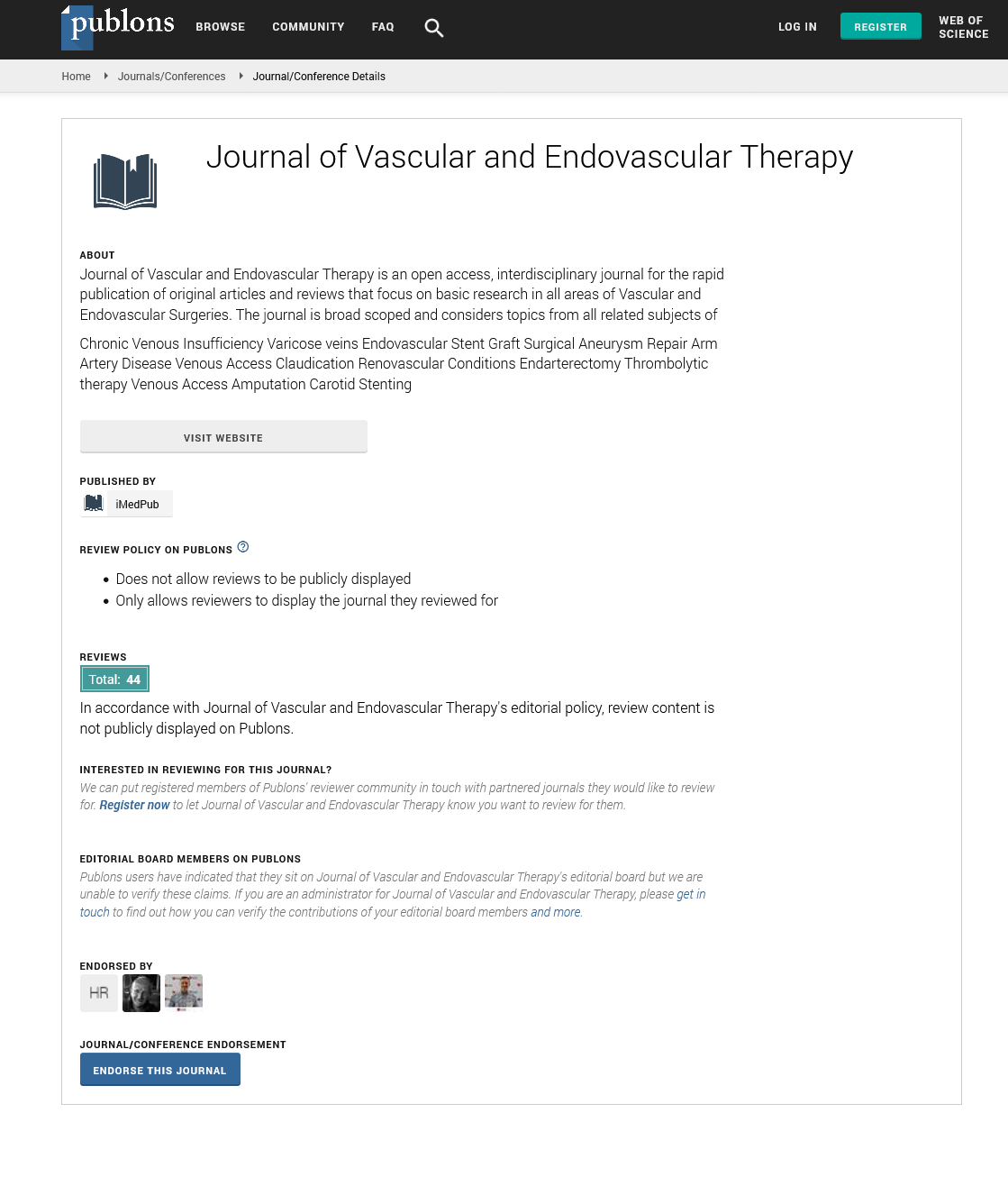ISSN : 2634-7156
Journal of Vascular and Endovascular Therapy
Chronic superior vena cava syndrome: Causes of venous shunt from the systemic to the cerebral circulation and causes of cerebrospinal sclerotic plaques formation
4th Edition of World Congress & Exhibition on Vascular Surgery
March 28-29, 2019 Rome, Italy
S Spagnolo
GVM Care & Research, Italy
ScientificTracks Abstracts: J Vasc Endovasc Therapy
DOI: 10.21767/2573-4482-C1-005
Abstract
The chronic upper caval syndrome runs asymptomatically. No symptomatic outcomes that characterize this condition have been identified. It is possible that anatomopathological changes and clinical pictures that could characterize moderate stenosis have been attributed to various neurological diseases such as multiple sclerosis, Parkinson’s disease, Meniere’s syndrome, etc. Only in recent years in patients with multiple sclerosis or Parkinson’s disease have the presence of stenosis of the jugular veins been detected. Little is known about the clinical pictures this pathology determines. With the introduction in the vascular diagnostics of the Ecocolordoppler, of the angiography and of the MRI, vascular flows and anatomopathological lesions that characterize these stenoses have been highlighted. At the Ecocolordoppler it is documented that the venous blood, coming from the brain, reached the point of stenosis, reverses its flow direction and re-enters the cerebral circulation. This inversion of the circulation has been called reflux. Starting from the concept that the venous circle has a unidirectional and centripetal flow and that a countercurrent flow is possible only in the compensation circles, we hypothesized and then demonstrated angiographically that the entire cerebrospinal venous system functions as a compensation circle. In our view, the reflux is not due to an inversion of the circolocerebral flow but to the venous blood that from the veins of the head, neck and throat reaches the jugular vein and, being unable to descend towards the heart, rises towards the cerebral circulation . It has been documented angiographically that blood from the jugular veins passes into the cerebral circulation, descends into the medullary circle, reaches the vein azigos and reaches the heart. The inversion of the circulation in the jugular vein and in the cerebral veins and the continuous passage of blood from the oral cavity, often the site of viruses, to the brain and the medulla open new perspectives in the knowledge of the mechanisms of brain plaque formation. In patients with jugular vein stenosis, the direction of cerebral venous circulation is impaired. The blood from the jugular veins, the sigmoid sinuses, the transverse sinuses and the superior sagittal sinus, to reach the medullary veins, must cross the right breast and its tributary branches. The sinus rectum is a single conduit, constantly subjected to an overload of pressure and volume and with a circulation that runs counter-current. It puts in direct contact the viruses present in the oral cavity or in the pharynx with the nervous tissue.All these factors compromise the blood-brain barrier and allow viruses and anti-viral antibodies to reach the brain where they trigger an inflammatory process with plaque formation. If further confirmations corroborate this hypothesis, it will be possible to conclude that the opening of jugular stenosis leads to the normalization of cerebrospinal circulation and the elimination of the causes that lead to the formation of inflammatory processes in multiple sclerosis and other neurodegenerative diseases.
Recent Publications
1. Sy W M and Lao R S (1982) Collateral pathways in superior vena cava obstruction as seen on gamma images. Br J Radiol 55:294-3004.
2. Francesco Puma and Jacopo Vannucci (2012) Superior vena cava syndrome, “Topics in Thoracic Surgery”, book edited by Paulo F Guerreiro Cardoso, ISBN 978-953-51-0010-2
3. Batson O V (1940) The function of the vertebral veins and their role in the spread of metastases. Ann Surg. 112:138-149.
4. Anderson R (1951) Diodrast studies of the vertebral and cranial venous systems to show their probable role in cerebral metastases. J Neurosurg. 8:411-422.
5. Arnautovic K I, Al-Mefty O, Pait T G, et al. (1997) The suboccipital cavernous sinus. J Neurosurg. 86:252-262.
Biography
S Spagnolo is a University of Milan graduate. He is a Specialist in General Surgery, Cardiovascular Surgery and in Thoracic Surgery. He works at the Istituto Clinico Ligure Alta Specialty (ICLAS) Rapallo (GE). He has published more than 125 articles.
E-mail: spagnolo.salvatore@libero.it
Google Scholar citation report
Citations : 177
Journal of Vascular and Endovascular Therapy received 177 citations as per Google Scholar report
Journal of Vascular and Endovascular Therapy peer review process verified at publons
Abstracted/Indexed in
- Google Scholar
- Open J Gate
- Publons
- Geneva Foundation for Medical Education and Research
- Secret Search Engine Labs
Open Access Journals
- Aquaculture & Veterinary Science
- Chemistry & Chemical Sciences
- Clinical Sciences
- Engineering
- General Science
- Genetics & Molecular Biology
- Health Care & Nursing
- Immunology & Microbiology
- Materials Science
- Mathematics & Physics
- Medical Sciences
- Neurology & Psychiatry
- Oncology & Cancer Science
- Pharmaceutical Sciences
